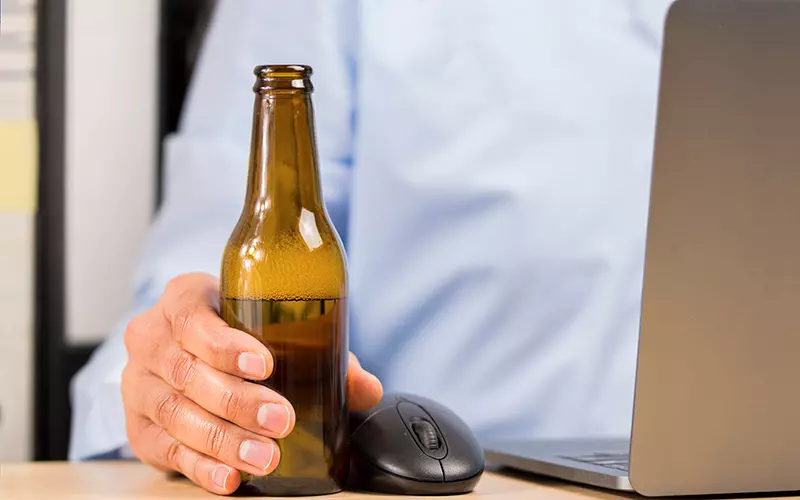Alcohol costs workplaces at least EUR 500 million a year

Excessive alcohol consumption reduces the quality of sleep and recovery from work. The individual's concentration during working hours suffers, and intoxicants pose a risk to the safety of the employee's colleagues and customers. Moreover, substance abuse and mental health issues may be connected in many ways − they can be the cause, effect or something in between. All intoxicants increase the risk of depression.
Substance use has a negative impact on a company’s productivity through sick leave absences, accidents both at work and at home as well as decreased efficiency and work ability. Unaddressed substance abuse can also have a negative impact on corporate image and customer relations.
Figures on the negative effects of Finnish alcohol consumption
- The majority of alcohol is consumed at home and around one million Finns are negatively affected by the alcohol consumption of a family member or friend.
- Among Finns, 1.2 million have experienced the negative consequences of drinking, such as arguments, accidents, regret or damage to property.
- Alcohol consumption costs Finnish companies at least EUR 500 million, possibly up to EUR 1 billion a year.
- The cost of people leaving the labour market prematurely is EUR 900 million a year.
- The cost of alcohol related absences is estimated to be EUR 282–424 million a year.
Substance use and intoxicants have changed
Experimenting with drugs has increased in Finland and an increasing number of drug users can be found in the workplace. Using and experimenting with cannabis has quadrupled from 6 percent to 24 percent compared to the 1990s. Experimenting with stimulants (e.g. amphetamine, ecstasy and cocaine) has also become more common, just under 5 percent.
However, cannabis has not replaced alcohol, rather its consumption has increased alongside alcohol. The cannabis used these days is more potent and may cause broader and more serious effects than before. Drugs, both traditional and designer drugs, have appeared alongside alcohol and their availability has improved as a result of digitalisation. Other types of behavioural addictions (such as money, digital, gaming and sex) are a growing challenge among the working-age population.
Substance abuse prevention programme to help the supervisor
It is increasingly difficult to identify substance use among employees. Multi-location work, where the employee rarely sees the supervisor or the rest of the team, makes this even harder. Identifying substance abuse is one of the most important challenges that concerns work ability. This means the employee receives the right care to facilitate getting things back on the right track. Occupational health care plays an important role in identifying and treating substance abuse problems.
A company’s HR department should ensure that it has a working substance abuse prevention programme and that supervisors act accordingly. The most important responsibility of the supervisor is to raise the subject and act according to the substance abuse prevention programme.
Tips for the supervisor:
- Consider, together with the company's management, what kind of drinking culture the company has and what it should be like.
- Familiarise yourself with and inform employees of the company’s substance abuse prevention programme. Take this into account during orientation.
- If you are concerned about an employee's fitness for work, don’t hesitate to speak up.
- If you suspect an employee is intoxicated or has a hangover, intervene immediately.
- Refer the employee to treatment as per the substance abuse prevention programme and keep up to date on its progress.
- Support the rest of the work community during sick leave if the situation has caused problems in the work community.
- When an employee returns to work after treatment, make a return-to-work plan together and keep the workload reasonable. Addicts are prone to workaholism so there is a risk of burnout.
Elo has been part of launching https://www.neuvoa-antavat.fi/ website together with Mehiläinen and A-Clinic Ltd. The site contains over 40 free video lessons that provide understanding, peer stories and tools for anyone who might be wondering if drinking plays an unnecessarily large role in their own, a family member’s, friend’s or colleague’s life. The service aims to, for example, provide tips for work communities on the prevention of alcohol-related problems.
Sources:
- Kaarlo Simojoki: Elo’s webinar ”päihteet ja työelämä” [“intoxicants and working life”]
- Juomatapatutkimus 2016, THL. (kaikki Suomen 15–79-vuotiaat vuoden 2017 luvuilla) [“Drinking Habits Survey 2016, THL. (all Finnish persons aged 15–79 with 2017’s figures)”]
- Miettinen & Rantapuska 2018: Numerot puhuvat - Kuinka tehokkaasti alkoholin aiheuttamia taloudellisia tappioita työpaikoilla voisi vähentää? [“Numbers speak - How effectively could alcohol-related financial losses be reduced in the workplace?”] EHYT Finnish Association for Substance Abuse Prevention.

 Menu
Menu
 Search
Search Language
Language
